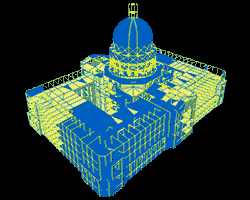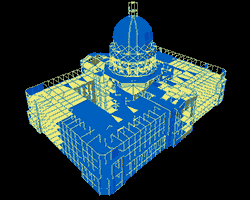Virtual Tour
of
San Francisco
City Hall
An illustrated guide to various items and areas of interest, their locations
and brief descriptions of their historic, artistic or architectural significance
This project does not represent and is not affiliated with
the City and County of San Francisco.

To leave comments and find additional information, visit us on
Facebook.
Mayor Daniel Lurie
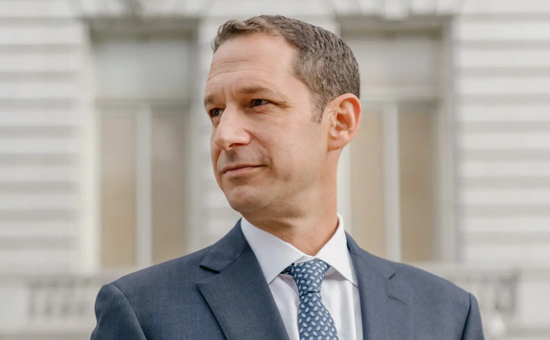
“Welcome to San Francisco City Hall.”
“This building has served the people of San Francisco for more than 100 years;
and I am proud that it will be here for generations to come.”
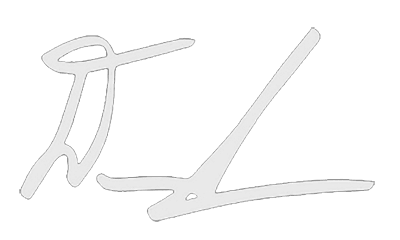

On November 5th, 2024, Daniel Lawrence Lurie was elected to become the 46th
Mayor of San Francisco.
He was born in San Francisco on February 4th, 1977,
and went to University High School. He earned a bachelor's degree
from Duke University in 1999, and a graduate degree from the
University of California, Berkeley in 2005.
Daniel Lurie is the founder and former CEO of Tipping Point Community, an innovative
non-profit organization that supports poverty-fighting organizations
throughout the Bay Area.
In 2006, he married Becca Prowda. Together they have a son and a daughter.
In 2019, his wife was named Director of Protocol by California Governor
Gavin Newsom. Mayor Lurie practices Transcendental Meditation.
City Hall Centennial
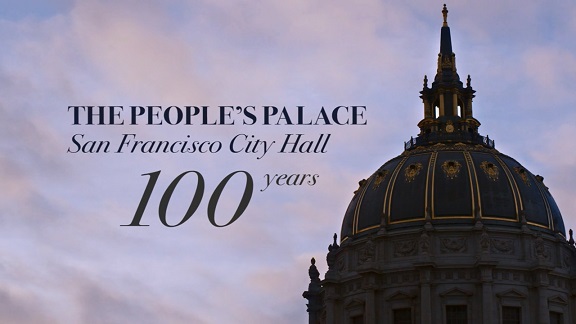
The year 2015 marked the 100th Anniversary of the completion, dedication
and opening of San Francisco's spectacular new City Hall. For this occassion, a half-hour
documentary film was produced to showcase City Hall throughout the last one hundred years.

Docent Tour Program
In 1999, then Mayor Willie Brown created the Docent
Program to guide members of the public through the restored magnificence of City Hall.
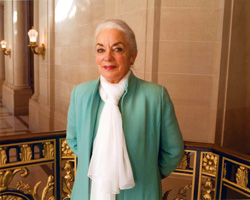
Ellen Schumer, the Docent Tour Program Manager,
will escort you and your group through this historic landmark.

Ms. Schumer hosts a short video about City Hall.

Panoskin 360° Tour
Click here to begin tour:
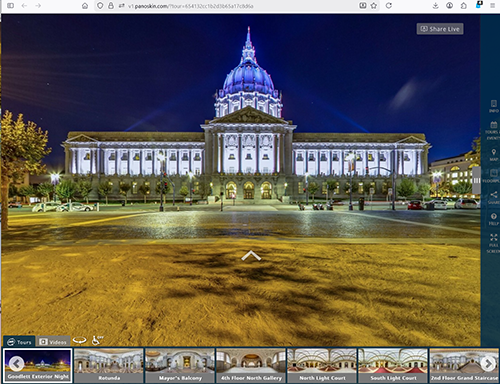
This is a modern, self guided photo tour of the inside and outside
of City Hall. The visitor can move down every hallway on every floor and look all
around at each stop along the way.
When clicked, the tour website will open as a separate tab. There is no log-in or user
account necessary, and no apparent advertising. This is the same “virtual real
estate experience” offered by the
City Hall Events Office
on their webpage.
The New City Hall
After the
Earthquake and Fire of 1906
destroyed most of San Francisco, a temporary seat of government was established in the nearby
Hotel Whitcomb,
where the plans for a new City Hall were conceived.
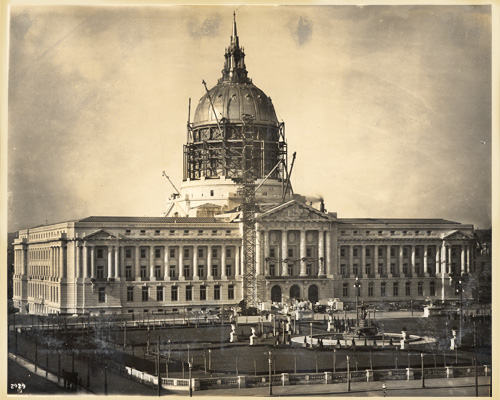
Construction began in 1913, and on December 28th, 1915,
Mayor James Rolph dedicated the new City Hall as a living monument to the strength,
resilience and determination of all San Franciscans.
City Hall Architects
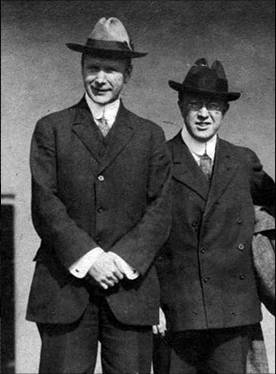
To build the new City Hall, a competition was held among
practicing San Francisco architects. John R. Bakewell, Jr. (left) and
Arthur Brown, Jr.
were chosen from among 72 applicants. Their first sketches of the new building
were done on the application envelope.
Bakewell was the general executive partner who oversaw specifications
and construction, and Brown was in charge of the overall design. Their associate,
Jean Louis Bourgeois,
was largely responsible for the beautiful interior design details.
Bakewell and Brown first met at UC Berkeley, and later studied together at the École
de Beaux-Arts in Paris. San Francisco City Hall is an elegant example of the
Beaux-Arts style,
which merges elements of French, Roman and Greek design.
Jean Louis Bourgeois
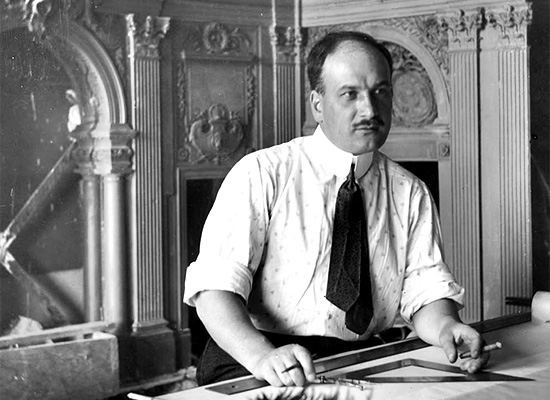
Jean Louis Bourgeois was an artist of great talent and remarkable taste.
Many of the most beautiful details of the City Hall are the product of his imagination.
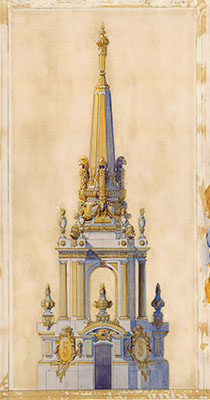
Born at Autun, France, in 1876, he was a pupil of Moyaux and Laloux at the Ecole des Beaux Arts,
Paris, where he had a brilliant academic career. He was appointed Government Architect by the Shah
of Persia, where he worked from 1906 to 1908. He went to San Francisco in 1908, leaving to join the
designing force of D. H. Burnham & Co., Chicago. He returned to San Francisco in 1912 to assist
Bakewell and Brown in the working out of the final designs for the San Francisco City Hall.
After the outbreak of the First World War, Bourgeois left his work in San Francisco and enlisted
in the French army. He was killed on February 26th, 1915, while fighting for his native country.
Henri Crenier
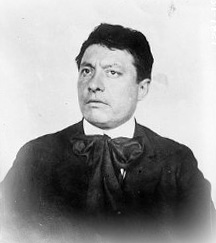
The most renowned of all the artists who were commissioned
to contribute to the new City Hall was certainly
Henri Crenier.
Working variously in carved granite, cast plaster
and cement, Crenier's achievements include two large
tympanums,
the "Father Time" sculpture, the rotunda medallions, four magnificent
telamones (one is
pictured below), as well as numerous friezes, bas reliefs and other motifs
that decorate both the inside and the outside of the building.
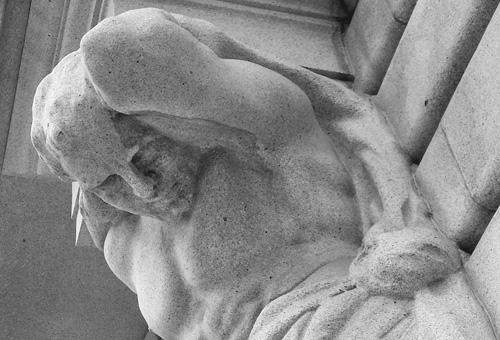
Crenier was born in Paris in 1873 where he attended
the same École de Beaux-Arts as did the two City Hall architects, Bakewell and Brown. He
emigrated to the United States in 1902, became a citizen in 1911, and died in
Westchester, New York in 1948.
City Hall Renovation
City Hall was badly damaged by the
1989 Loma Prieta Earthquake.
Soon afterwords, the State of California enacted a massive retrofit program to repair the
structure and protect it against damage from future earthquakes.
The two-block-long building was cut from its foundation and now "floats"
on 530 elastomeric bearings or shock absorbers designed to dissipate earthquake motion and allow
the building to sway horizontally up to 26 inches.
To install the isolators, engineers jacked up the supporting columns of the
building one at a time, cut the columns, positioned the isolators under them and then restored
the building's weight to the structural members.
Superstructure strengthening included a new ground floor constructed above the isolators, concrete
shear walls around the Light Courts, steel collectors to deliver seismic forces to the new shear
walls, reinforcement of the Rotunda tower walls, and installation of steel braces and shotcrete walls
at various levels of the Dome.
The Dome itself was reinforced with 1,200 tons of steel to prevent
a repeat of the four inch "corkscrew" twist it received in the 1989 quake.

Seismic Monitors
During the renovation, the California Department of Conservation
installed 18 seismic sensors throughout City Hall as part of the
Strong Motion Instrumentation Program.
These "accelerometers" provide valuable data about earthquake shaking and the building's response.
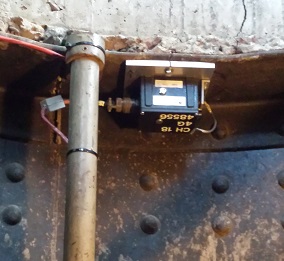
Sensors such as this one mounted just beneath the Dome's Lantern Structure send data to the
Center for Engineering Strong Motion Data
, a joint center of the U. S. Geological Survey and the California Geological Survey.
Modern Technology
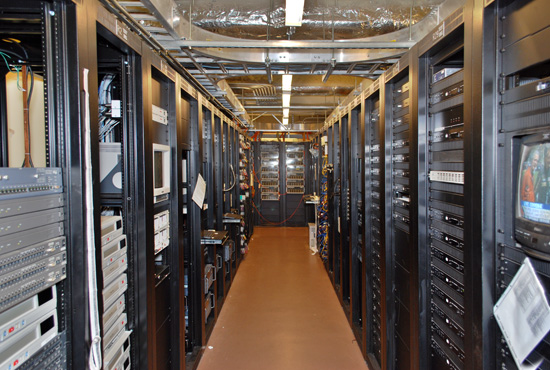
State of the art technology was utilized
and installed during the restoration of City Hall.

Fiber-optic technology allowed many existing
conduits to be used instead of changing the historic building.
City Hall Today
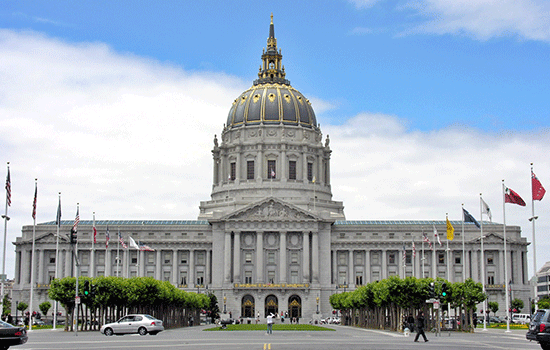
Badly damaged by the
1989 Loma-Prieta earthquake,
San Francisco City Hall was closed to the public throughout the 1990's.
After being restored and extensively renovated,
it re-opened for business on January 5th, 1999.
City Hall Size

San Francisco City Hall is a huge structure, occupying two
city blocks. It contains over 550,000 square feet of space.
City Hall Dome
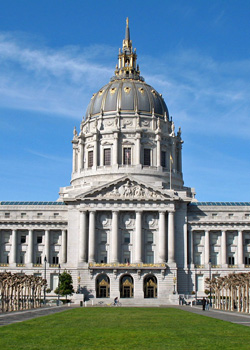
The Dome of San Francisco City Hall is the
tallest in the United States.
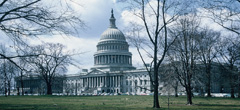
Eastern face of U. S. Capitol building
At 301 feet, 5½ inches, the top of the dome's Lantern structure
is 13 feet higher than the top of the Statue of Freedom on the dome of the
U. S. Capitol building in Washington, D.C.

Press to begin a Virtual Tour of the Dome.

Central Rotunda
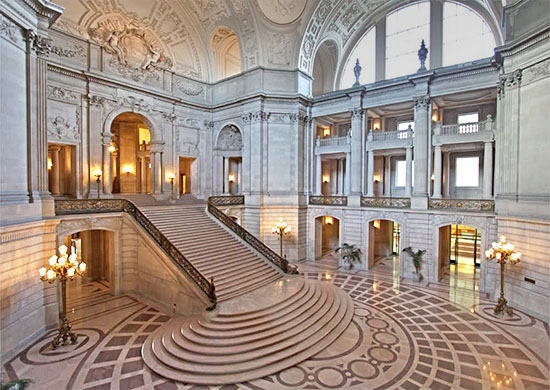
Within the magnificent Central Rotunda, the principal
feature is a Grand Staircase facing the eastern entrance. Rising to the
second story, it leads to the Chamber of the Board of Supervisors.
The columns and walls of the rotunda are finished in
Indiana limestone
and Madera County granite from the nearby Sierra-Nevada mountains.
Between the columns, a classical balustrade surrounds the rotunda
at each of the upper floors. Doors, wainscotting, mouldings and other
interior finish are of Manchurian or Siberian oak. The stairs and the
floor, which features an intricate design, are made out of
Tennessee pink marble.
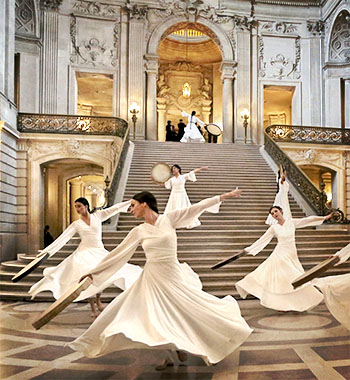
The Central Rotunda is often the scene of
ceremonies and events, ranging from inaugurations and receptions for
visiting dignitaries to state funerals and memorial services, weddings,
dances, musical performances, film production and exhibits.
The Rotunda Dance Series presents the
Nava Dance Collective
in a performance at City Hall.
Rotunda Medallions

The interior design of the Rotunda features
four large round Medallions created by the famous sculptor Henri Crenier.
Each medallion is incorporated into a
pendentive
at the top of a massive, three-story-high tower or
pier
located at each of the four corners of the Rotunda.
The fine detail of the Medallions
can be seen best from the Fourth Floor Gallery.
Medallion of Equality

The Medallion of Equality presents a cloaked female
figure holding an equilateral triangle.
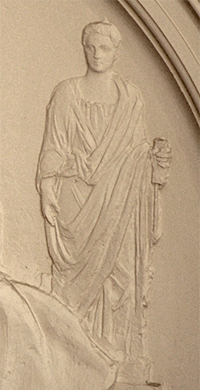
The figure in the background is believed to represent the 1st Century Roman
rhetorician and philospher,
Quintilian, who wrote that the perfect orator must
remain true to a message that is "just and honorable." If one cannot be a genuinely good man, he reasoned,
then one cannot be a good speaker for the people. Centuries later, Quintilian's work provided
the inspiration for a new humanistic philosophy in education, music and the arts in Europe.
Medallion of Liberty
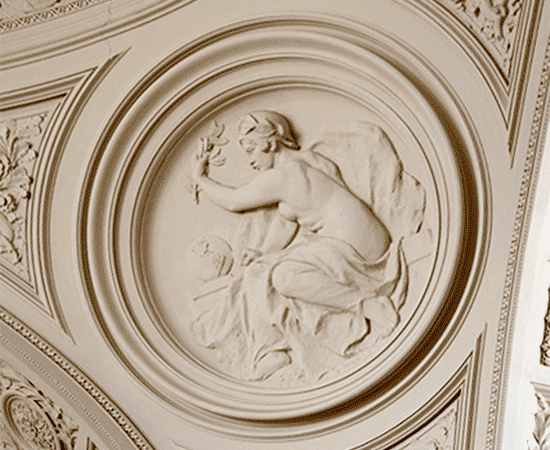
The Medallion of Liberty is extending an olive
branch in a gesture of peace and liberty to all people of the world.
Medallion of Strength

The Medallion of Strength represents
the power of our legislative system. The sword-wielding figure in
the Medallion looks toward the Chamber of the Board of Supervisors.
Medallion of Learning

The Medallion of Learning represents the
importance of education. The Medallion depicts a teacher imparting the
skill of reading to a group of small children. The children represent
our future.
Rotunda Embellishments
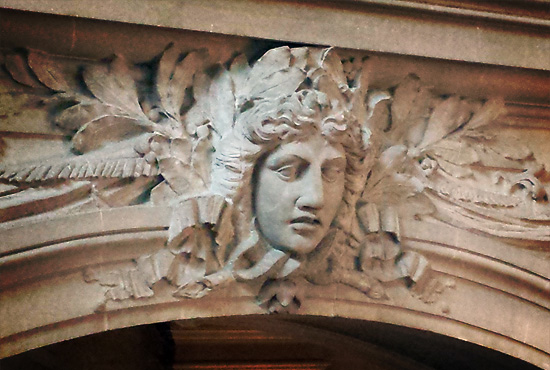
There are many special embellishments
throughout the Rotunda. Greek mythological faces surround the first level
of the Rotunda.
Grand Staircase

The Grand Staircase leads from the Rotunda floor
up to the Ceremonial Rotunda. Beyond that are the doorways to the Chamber of the
Board of Supervisors.
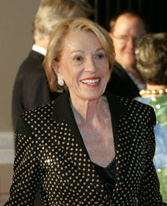
In December of 2010, a plaque was unveiled that dedicated this staircase to
Charlotte Maillard Shultz
in honor of her service as Chief of Protocol for San Francisco.
Board of Supervisors
The Board of Supervisors consists of eleven
representatives, elected from each District of the City.
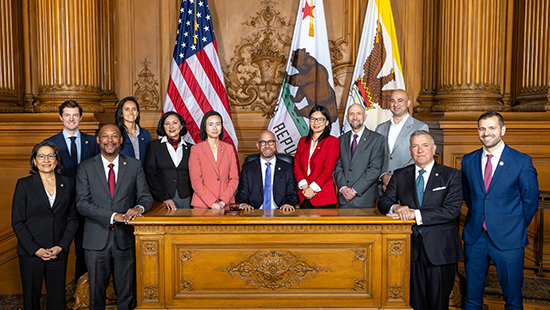
Board of Supervisors Inauguration Photo, January 8th, 2025
From left to right:
Angela Calvillo (Clerk), Stephen Sherrill, Shamann Walton,
Jackie Fielder, Myrna Melgar, Connie Chan,
Rafael Mandelman (President of the Board), Chyanne Chen,
Joel Engardio, Bilal Mahmood, Matt Dorsey, Danny Sauter

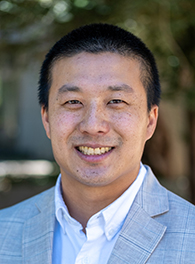
Alan Wong, a lifelong resident of the Sunset District and an elected trustee for San Francisco
City College, was appointed by Mayor Lurie on December 1st, 2025, to represent District 4 as its new supervisor.
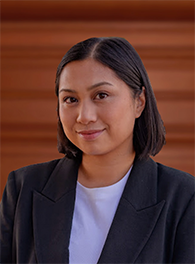
He will serve for the remainder of the term of Joel Engardio, who was recalled by voters on September 16, 2025, the first supervisor to be successfully recalled by voters in the Board's 169-year history, and Beya Alcaraz, who was appointed on November 6th, 2025, but resigned after just one week in office.
Supervisors' Chamber
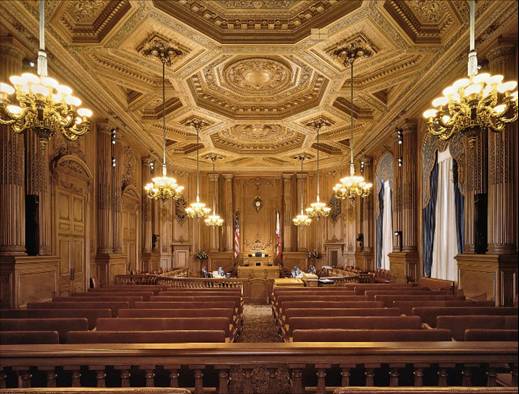
In this photograph, the magnificent Chamber of the Board
of Supervisors is shown after its renovation in 1999.
The chamber is located in Room 250.

This rare photograph is of the Supervisors' room in the old San Francisco City Hall
before it was destroyed in the 1906 earthquake and fire.
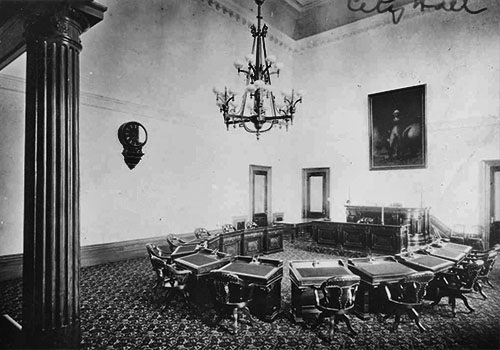
Chamber Dedication
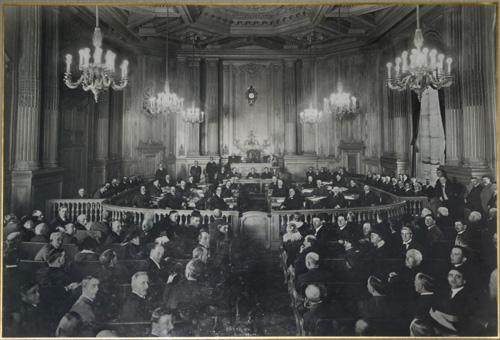
Near the entrance to the Chamber of the Board of Supervisors, this
large format photograph depicts the chamber's dedication ceremony on October 9th, 1916.
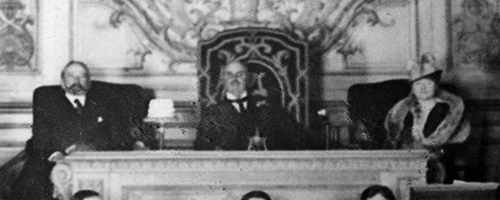
At the center, U. S. Senator and former mayor James B. Phelan,
Mayor James Rolph and his wife, Annie, are seated at the President's Dias.

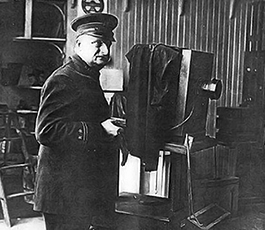
The photo was created by
famed San Francisco Police Photographer, George W. Blum.
Ornate Wood Paneling
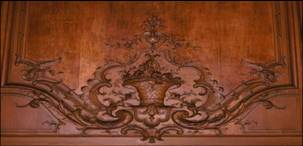
The wood paneling in the
Board Chamber is Manchurian Oak.
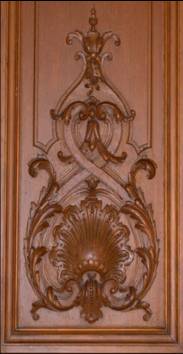
Manchurian Oak is softer
and easier to carve than California Oak.
There are no more forests of Manchurian Oak left in the world. These
carvings cannot be recreated.
Public Seating
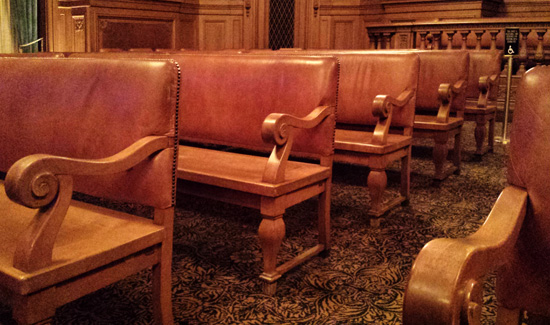
The benches, railings and desks in the Chamber
are made of a harder California Oak.
Ceiling Design
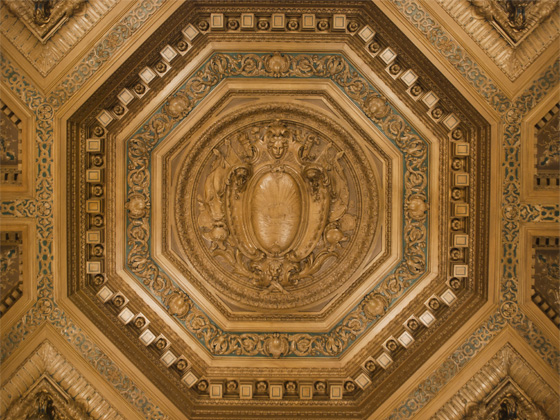
The ceiling in the Board Chamber looks like wood but is actually cast
plaster, enhanced to show off the magnificent detail.
San Carlos
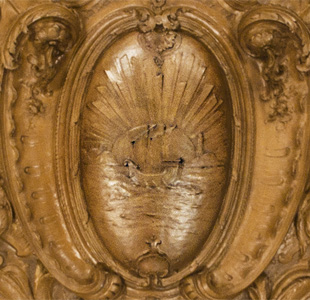
In the center of the ceiling, the image of a ship is visible.
This was the San Carlos, which on August 5th, 1775, under the command of
Juan Manuel de Ayala,
became the first European vessel known to enter and explore San Francisco Bay.
Four Demons

The plaster work above the public speaking area includes
four demon heads. The legend is that this was done because the public
always makes trouble for the elected officials.
Floor Covering

The original floor covering in the Board Chamber was
Portuguese cork parquet. The cork wood was replaced with carpeting during
the 1990's renovation.
The pattern in the carpeting features the
Dahlia. In 1926 Mayor
James Rolph declared the Dahlia to be the official flower of San Francisco.
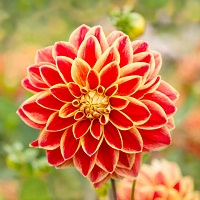
The earliest Western record of the flower was made
in the 1570's by the Spanish Renaissance physician
Francisco Hernández de Toledo
who described it during his seven-year study of New World flora.
The Dahlia is also the national flower of Mexico.
Window Coverings
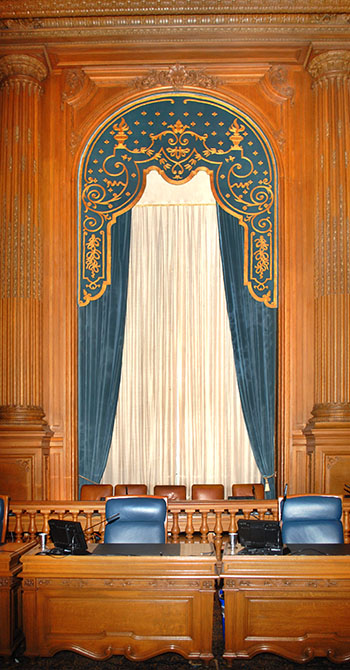
The window coverings in the Board Chamber
incorporate unique decorative gold borders known as
soutache.
Ceremonial Rotunda

The Ceremonial Rotunda is where many vows of marriage
and domestic partnership are solemnized.
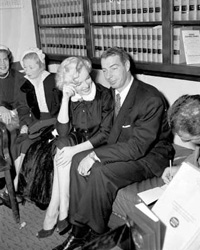
Perhaps the most famous City Hall wedding was that of
Joe DiMaggio and Marilyn Monroe.
They were married on January 14th, 1954 by Municipal Judge Charles S. Peery
in his courtroom on the third floor. Today, the old courtrooms are used for office
space. Volunteer Marriage Commissioners, deputized by the County Clerk's office,
solemnize most City Hall marriages.
Harvey Milk

Harvey Bernard Milk became the first openly gay elected official
in California when he won a seat on the San Francisco Board of Supervisors. He served on
the Board from January, 1978 until his assassination on November 27th of that same year.
This 24 inch bronze bust and its unique 56 inch granite pedestal are the work of the
Daub, Firmin and Hendrickson
Sculpture Group. It was installed in the Ceremonial Rotunda near
the entrance to the Board Chamber in May, 2008.
John Taylor Room
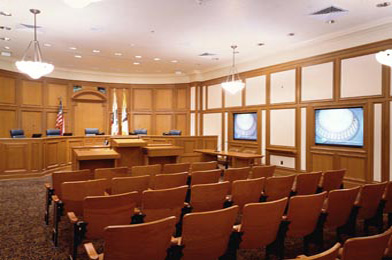
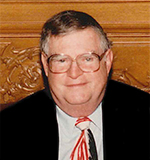
In 1998, the Board of Supervisors Committee
Meeting Room was named to honor John L. Taylor for his 16 years of service
as Clerk of the Board. It is located in Room 263.
Mayor's Balcony
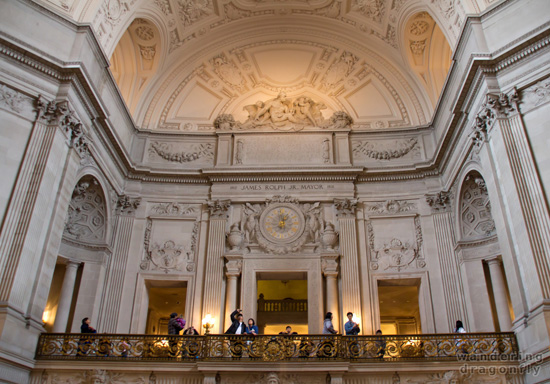
The Mayor's Balcony and East Wall as seen from
the floor of the Rotunda.
The Mayor's Balcony is used for special occasions such as
swearing in City Commissioners or welcoming Consular Officials and other dignitaries.
It is also a favored location for larger wedding ceremonies.
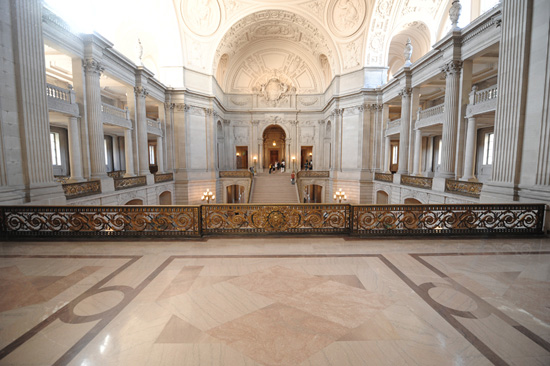
Looking west from the steps of the Mayor's Ceremonial Rotunda,
the floor and railing of the Mayor's Balcony are in the foreground.
Father Time
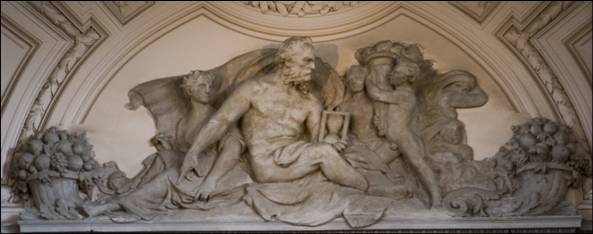
High above the Mayor's Balcony, on the east side of the
Central Rotunda, the figure of Father Time is realized by the sculptor Henri Crenier.
Father Time holds an hourglass and, while pointing back toward History, depicted
as a scribe seated behind him, he looks ahead to a radiant Future, bearing the
Torch of Progress.
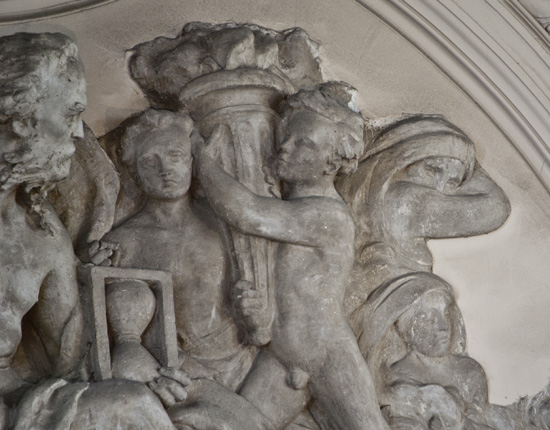
On the right and in the background, mysterious cloaked
figures of a woman and her child appear to flee the stern gaze of Father Time.
Some suggest they symbolize the Fleeing Hours of the Day; or they may personify
a popular sundial motto from an 18th Century hymn by Isaac Watts that says:
"Time, like an ever rolling stream, bears all its sons away."
Father Time Inscription

There is an inscription directly beneath Father Time, written
by Mayor Edward Robeson Taylor:
SAN • FRANCISCO • O • GLORIOVS • CITY •
OF • OVR • HEARTS • THAT • HAST • BEEN • TRIED •
AND • NOT • FOVND • WANTING • GO • THOV • WITH •
LIKE • SPIRIT • TO • MAKE • THE • FVTVRE • THINE
Dedication to Mayor Rolph

A dedication to Mayor James Rolph, Jr. is carved into
the granite below the “Father Time” frieze and the inscription by
Mayor Robeson Taylor. Mayor Rolph was the visionary who insisted that the City
of San Francisco build this magnificent structure.
Beneath the dedication to Mayor Rolph is a large, historic
clock face designed by local jeweler, watchmaker and Austrian immigrant Albert
Samuels, founder of the Albert S. Samuels Co. The hands and
numerals of the clock are finished in gold.
Mayor's Office
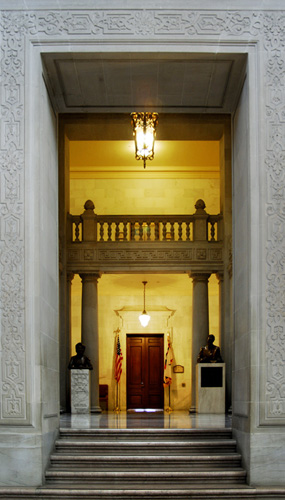
The Mayor's Office is located in City Hall Room 200.
Seen from the Mayor's Balcony and across the Ceremonial Rotunda, the flags of the
United States and of San Francisco stand on either side of the entrance doors.
Mayor's Reception

Members of the public and official visitors
are first welcomed to the Mayor's Office in the Reception Area
of Room 200.
International Room

The International Room is the site
of many high level meetings and receptions.
Hallway of Alcaldes
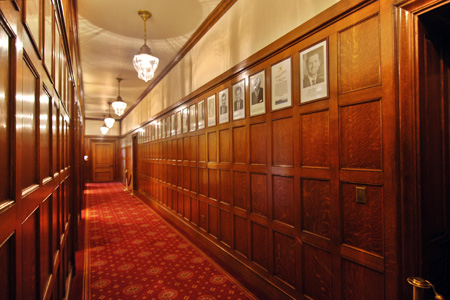
The hallway leading to the Mayor's office is lined
with images of former San Francisco Mayors and Spanish Alcaldes. This area
is not usually open to the public.
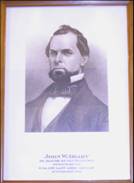
After the defeat of Mexico in 1848, the U. S. military governors of California
left the Alcalde system intact until it was superseded by a new
state constitution. On May 1st, 1850,
John W. Geary,
the last Alcalde of San Francisco, was elected as the city's first mayor.
Mayor's Desk
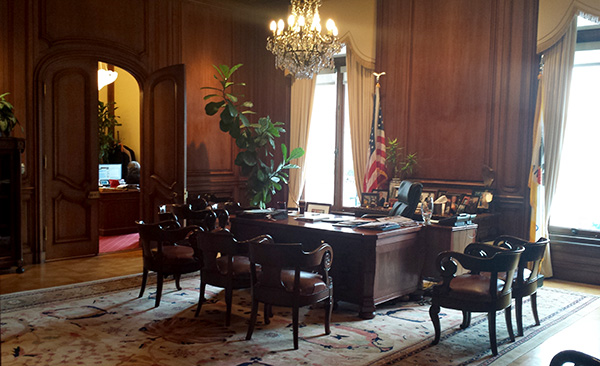
Since 1915, every mayor has used this historic desk
and the original office furnishings of this room. However, each new
mayor will arrange and decorate the office in their own unique style to
reflect their personal history, taste and the manner in which they intend
to conduct the city's business.
Citywide Communication
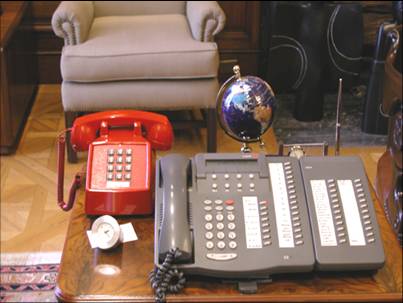
Near the Mayor's desk are the phones
used to contact and direct all City emergency officials.
City Hall Mementos
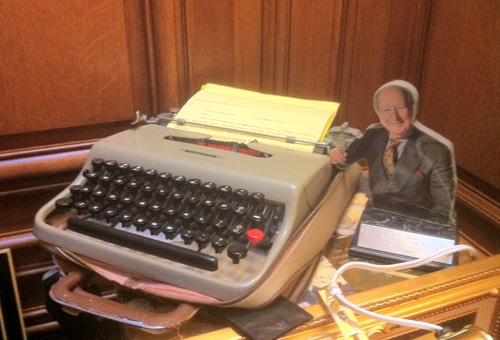
The Mayor's Office of Protocol recognizes
Herb Caen as someone who epitomized the spirit of San Francisco. He
is honored with a display in this office.
Mayor's Rotunda
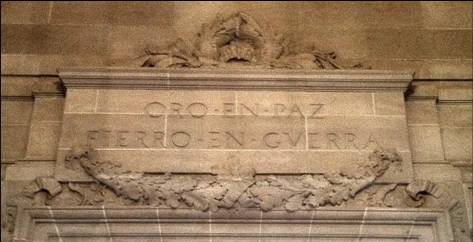
ORO • EN • PAZ
FIERRO • EN • GVERRA
"Gold in Peace / Iron in War"
The motto of San Francisco is inscribed
inside the Mayor's Ceremonial Rotunda above the entrance to the
Mayor's Balcony.
George R. Moscone
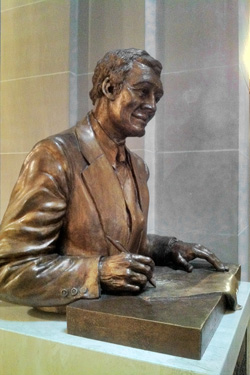
Supervisor and State Senator
George Richard Moscone
served as the 37th Mayor of San Francisco from 1972 until the moment
of his assassination on November 27th, 1978.
This larger than life-size cast bronze sculpture was created by
Spero Anargyros
and is located in the Mayor's Ceremonial Rotunda on the second floor.
A twin of this casting is on display at the nearby Moscone Convention Center.
A plaque on the pedestal includes a famous quote from the Mayor
about the city he loved:
"San Francisco is an extraordinary city,
because its people have learned to live together with one another, to respect each
other, and to work with each other for the future of their community. That's the
strength and the beauty of this city --- and it's the reason why the citizens who
live here are the luckiest people in the world."
Dianne Feinstein

U. S. Senator
Dianne Goldman Berman Feinstein
was President of the Board of Supervisors when she succeeded Mayor George Moscone
to become the 38th Mayor of San Francisco. The first woman to hold the position,
she was formally elected one year later, and then re-elected to a second
full term after that. She served as mayor from 1978 to 1988.
Sen. Feinstein, a native San Franciscan, graduated from
Convent of the Sacred Heart High School and earned a Bachelor of Arts in History from Stanford
University. Throughout her distinguished career, she has received several honorary
degrees and awards including one of France’s highest honors, the Légion d’Honneur, bestowed
on her in 1984 by French president François Mitterrand.

Including its marble base, the bronze sculpture stands
almost seven feet tall. It was created in 1996 by
Lisa Reinertson
and is located on the 2nd Floor in the Mayor's Ceremonial Rotunda.
Senator Feinstein's engagement ring has become highly polished from
the touch of her many visitors.
Willie L. Brown, Jr.

Speaker of the California State Assembly, criminal defense
attorney, and eternal champion of civil rights, Willie Lewis Brown, Jr. served as
the 41st and first African-American Mayor of San Francisco from 1996 to 2004.
In recognition of his tireless efforts in the restoration of City
Hall, this bronze sculpture was created by California artist Richard MacDonald. It was
donated to the City and dedicated on January 5, 2004. It is installed in the
Mayor's Ceremonial Rotunda on the second floor.
Gavin C. Newsom
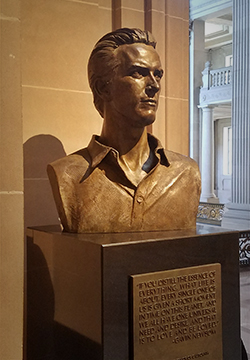
California Governor
Gavin Christopher Newsom
brought national attention to the issue of same-sex marriage when, on February 12th, 2004,
just one month into his first term as mayor, he directed San Francisco's County Clerk
to issue marriage licenses to same-sex couples in violation of then-current California
state law. This unexpected act of civil disobedience led to the
2015 Supreme Court decision
that struck down bans on same-sex marriage throughout the United States.
Born in October, 1967, Gavin Newsom was first appointed to the Board of Supervisors by then Mayor Willie Brown in 1997. Subsequently winning election as supervisor in 1998 and re-election twice more, in January, 2004, Gavin Newsom became the youngest person ever to be elected as Mayor of San Francisco.
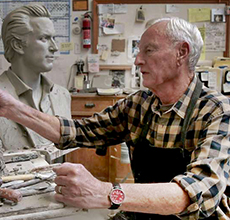
This likeness of Mayor Newsom was installed in City Hall on June
24th, 2018. The bust is mounted on a freestanding stone base
that holds a bronze dedication plaque. The sculpture was created by
Bruce Wolfe, who lives and works at his home in nearby Piedmont, Califorrnia.
Historic Elevators
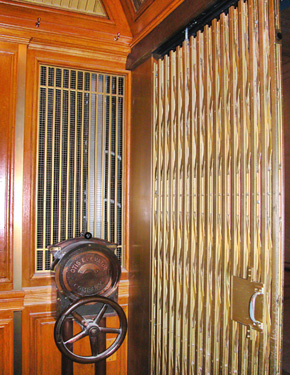
In 1916,
City Hall elevators
were known affectionately as “birdcages” and were operated by
white-gloved attendants. Passengers could view other elevators going
up and down through the metal bars.
Today all but three have been replaced by modern elevators,
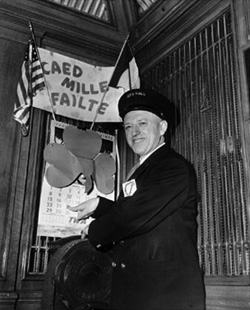
A City Hall elevator
is decorated for
St. Patricks Day, 1953.
Elevator Designs
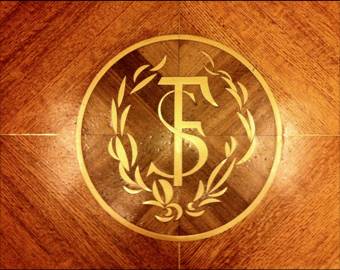
The magnificent, vertical grain,
red oak
hardwood floors of the elevators are inlaid with the monogram of San Francisco
in brass. Here the entwined letters "SF" are crowned by a delicate, horseshoe shaped
wreath of laurel leaves,
a feature of Beaux-Arts architecture, encircled by a slender ring.
Window Design
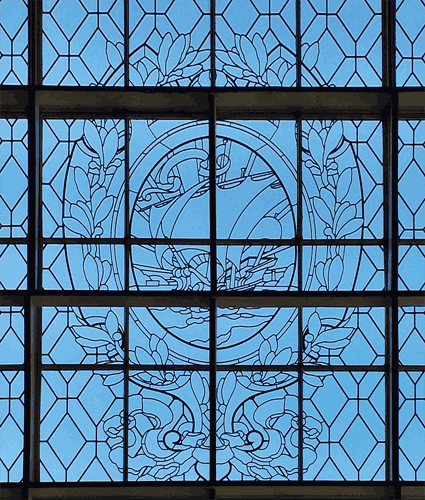
Along the fourth floor gallery, another image
of Ayala's ship, the San Carlos, is incorporated into the design of the
leaded glass windows.
Accessibility
City Hall is completely ADA accessible.

Ramps were added during the renovation to make access
across the Rotunda possible.
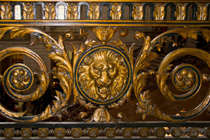
The original ironwork designs
that encircle the Rotunda and the Main Staircase are
replicated in the new railings.
Light Court Skylights
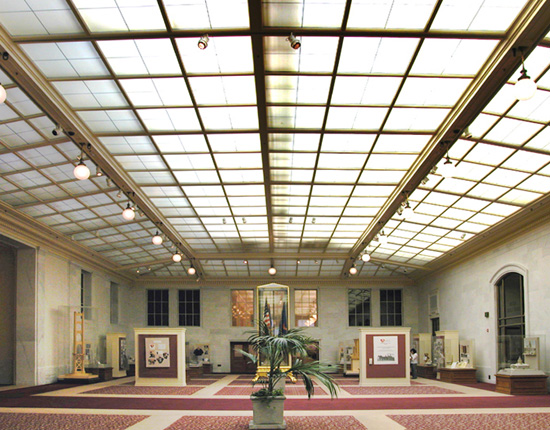
During the 1990's renovation, a covering was removed that
had been put over the light court skylights during an earlier expansion of office space.
This allowed natural light to properly illuminate the main floor of City Hall
once again.
South Light Court
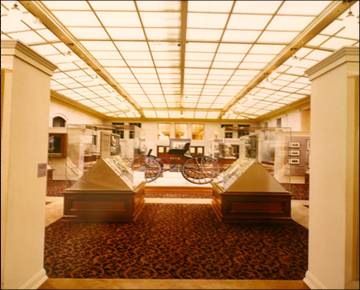
The South Light Court houses rotating exhibits that
chronicle significant events in San Francisco history.
Ceremonial Silver Shovel

One exhibit in the South Light Court features
a ceremonial Silver Shovel used by Mayor Jim Rolph to raise the first
shovel of dirt for construction of the new City Hall on April 5th,
1913.
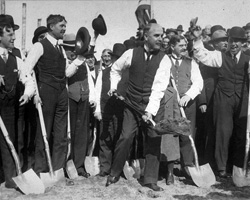
City Treasury Vault

In the South Light Court is one of the original vaults for
the City and County Treasury. It was designed and built by the Herring Hall
Marvin Safe Co. of Hamilton, Ohio.
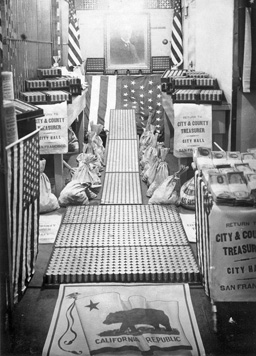
In 1916, the entire cash
reserves of San Francisco,
including almost two tons
of gold dust, coins and
bars were displayed
in the new vault.
Goddess of Progress

On display in the South Light Court is all that remains
of the twenty foot tall
Goddess of Progress
that once stood atop the dome of old City Hall.
Sculpted in 1896 by
Francis Marion Wells,
the statue was cast in a semi-bronze metal alloy and weighed several tons.
Modeled after the artist's wife, it held a torch aloft and was said to look
extremely poised and graceful. The head, some 48 inches from crown
to base, is adorned with a peaked
Phrygian cap
and a wreath whose thick leaves provided sockets for recently introduced electrical light bulbs.
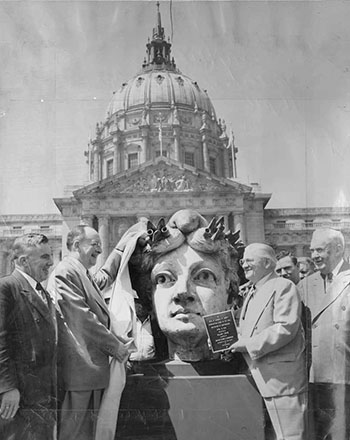
After removal from the ruins in 1909, the statue's head was given to the family of
William Irvine, and eventually ended up in the basement of his business at 1066 Mission St.
There, in 1949, he asked Jack Shannon, the chauffeur of Mayor Elmer Robinson, if the City would like
to have it back. Mr. Shannon said he would ask the mayor. On April 19th, 1950, the head was ceremoniously
returned to the city to be placed in the new City Hall.
City Hall Clocks

Originally there were more than 100 clocks in City Hall,
all synchronized to a single master clock in the office of the Building Engineer.
After the restoration, only 39 remain, including this one in the South Light Court.
Designed by Albert S. Samuels, a San Francisco jeweler,
and built by the Mayer Brothers of Seattle, this clock and its twin in the North Light
Court have two faces. The hands on either side turn in opposite directions.
In keeping with tradition, the number 4 is rendered in
Roman numerals as “IIII” instead of the more common “IV”.
Some feel that this creates a more balanced and pleasing design.
Infantry Flags Exhibit
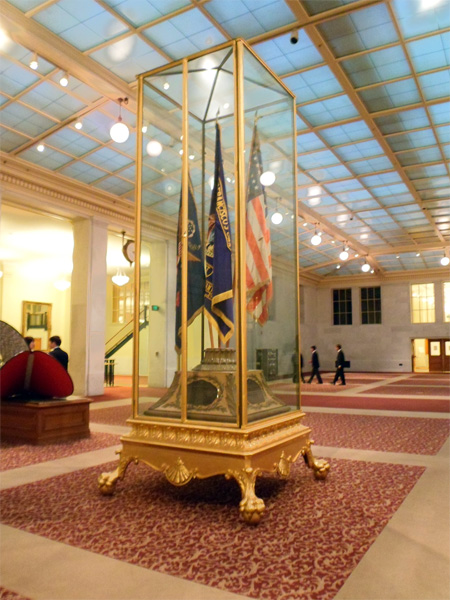
A permanent exhibit in the South Light Court honors San Francisco's
own 363rd Infantry Regiment, the “Golden West Regiment.” The exhibit
commemorates their combat action at the
Battle of the Meuse-Argonne.
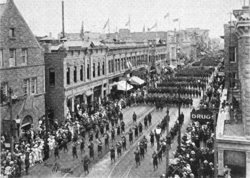
The 363rd was formed at Camp Lewis, Washington,
on September 5, 1917, as part of the 91st “Wild West” Division. The
regiment shipped out to the war in France on May 6, 1918, traveling through
Canada on their way. Final demobilization was conducted at the Presidio of
San Francisco on May 2, 1919.
North Light Court
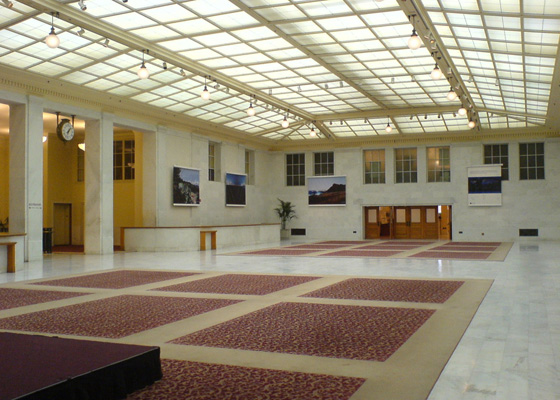
A variety of Civic and private events are hosted
in the North Light Court.
Michael O'Shaughnessy
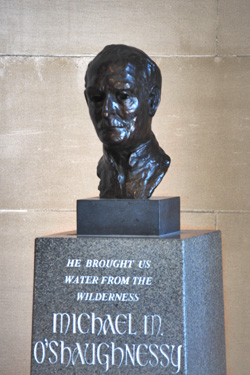
In September, 1912, then Mayor Rolph persuaded
Michael Maurice O'Shaughnessy
to become San Francisco's Chief Engineer.
O'Shaughnessy supervised the construction of the Twin
Peaks Reservoir, the Stockton Street Tunnel, the Twin Peaks Tunnel, the
Municipal Railway System, service to the Panama-Pacific International Exposition,
a high-pressure water system for fighting fires and many new sewers and streets.
By far his most controversial achievement was the completion
of a dam on the Tuolumne River, flooding the entire
Hetch Hetchy Valley
in the northwestern part of Yosemite National Park.
This bust, a gift of his daughter, Elizabeth, was created by the
Irish artist, Don Cronin. A twin casting of the bronze sculpture is installed in
the rotunda of the Califonia State Library & Courts Building II in Sacramento,
which is dedicated in honor of the famed San Francisco City Engineer.
Adolph Sutro
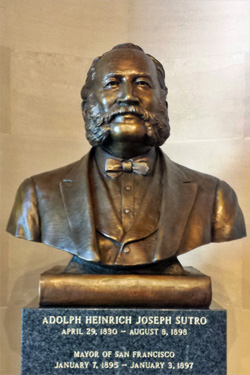
Adolph Heinrich Joseph Sutro,
was the 24th and first openly Jewish Mayor of San Francisco. He served from 1895 to 1897.
Prussian-born, Sutro was an engineer, hydrologist and entrepreneur who
conceived and built a much needed drainage and ventilation tunnel under the notorious
Comstock silver lode.
Sutro increased his considerable wealth with large investments in San Francisco
real estate. Today, he is best remembered for the many landmarks that still bear his name,
including Mt. Sutro and the famous Sutro Baths.
This bronze bust on a granite pedestal was designed by Jonah
Hendrickson with consultant-advisor
Inna Polnar. A gift of the United
Humanitarian Mission, it was unveiled on April 29, 2013, and
installed on the first floor near the Van Ness Avenue entrance.
Angelo Rossi
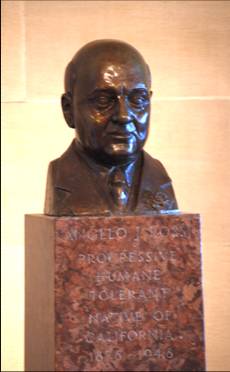
President of the Board of Supervisors
Angelo Joseph Rossi
became San Francisco's 31st mayor when Mayor Rolph resigned to become Governor
of California. Subsequently elected and then re-elected, Mayor Rossi served from 1931
to 1944.
Mayor Rossi was a proponent of the New Deal and worked hard to bring Federal
Government money and programs to San Francisco to create jobs and modernize the City.
Mayor Rossi presided over the opening of the Golden Gate Bridge in 1936 and the
San Francisco-Oakland Bay Bridge in 1937. He led the groundbreaking ceremonies for
San Francisco City College in April 1937, and he presided over the building of Treasure Island
and the Golden Gate International Exposition (World's Fair) of 1939.
His statue is located on the first floor in the lobby
of the Van Ness Avenue entrance.
Edward Robeson Taylor

Doctor, lawyer, teacher and poet,
Mayor Taylor
brought order and stability during a turbulent time. Like a wise elder
statesman, he presided over a city shattered by the elemental forces
of nature, and filled with scandal and corruption.
Appointed by the Board of Supervisors, he served as San Francisco's
28th mayor for only three years, from 1907 to 1910. He never sought
to be elected.
This bronze bust on a granite base was sculpted by Haig Patigian,
and it is located near the Van Ness Avenue entrance on the first floor.
Frederick Funston
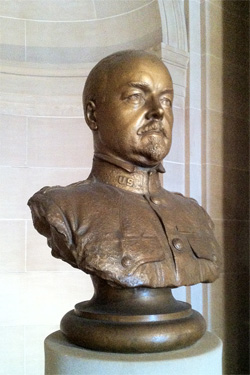
Maj. Gen. Frederick N. Funston and his men acted heroically
during the 1906 earthquake and fire to protect the City and preserve order.
This bust of Gen. Funston is located in the lobby
of the Van Ness Avenue entrance on the first floor.
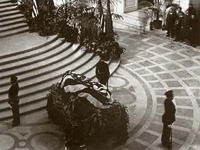
His funeral in 1917 was the first
to be held in the Main Rotunda of the new City Hall. He is buried in the National
Cemetery at the Presidio of San Francisco.
John Shelley
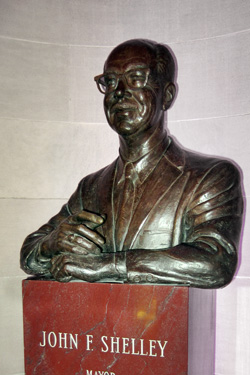
Congressman John Francis "Jack" Shelley served as the 35th Mayor of
San Francisco from 1964 to 1968. He was the first Democrat to be elected
in 50 years, and began a line of Democratic mayors unbroken to this day.
He was a strong proponent of civil rights throughout his career.
This bronze bust was executed in 1992 by sculptor
Lisa Reinertson.
It is located in the lobby of the Goodlett Way entrance on the first floor.
George Christopher

Former Supervisor and Board President, George Christopher
served two terms as the 34th Mayor of San Francisco from 1956 to 1964.
He was the first Greek-American mayor of any major American city.
Born in Arcadia, Greece, his family came to San Francisco when he was only
two years old. His childhood experience of anti-Greek sentiment informed his
strong stand on civil rights.
Mayor Christopher helped bring the Giants baseball team from New York in 1958
and secure the funding to build Candlestick Park. He oversaw the redevelopment of
many city districts including the Embarcadero Center, Japantown and the Fillmore.
His administration is credited with building Brooks Hall, twelve new schools,
seventeen firehouses, six public swimming pools and two public parking garages.
This bust of Mayor Christopher is located in the Goodlett Way entrance
on the first floor.
Edwin M. Lee
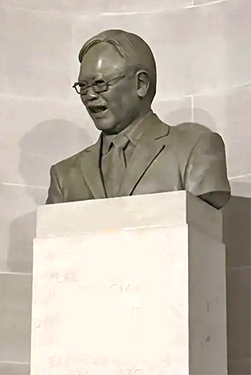
Edwin Mah Lee
was the 43rd Mayor of San Francisco from 2011 until his unexpected death in 2017.
Mayor Lee presided over the City's first tech boom, which created more than 140,000 new jobs. He signed one of the nation’s highest minimum wage laws and revamped public housing. He is also remembered as the City's first Asian-American mayor.
Mayor Lee graduated from Bowdoin College in 1974 and earned a law degree from UC Berkeley. He gained prominence in 1977 when he fought to prevent the demolition of a senior housing unit called
The International Hotel. In 1989, Mayor Art Agnos invited Lee to head the City's new whistleblower program. Over the years, Lee rose steadily up the ranks, including as the head of the City’s Human Rights Commission, Director of City Purchasing, Director of Public Works and finally as City Administrator, the highest unelected position in San Francisco government.
“Ed Lee may have been the most experienced person to ever hold the job of CEO of the City and County of San Francisco,” said former Mayor Willie Brown. “He is a significant historic figure for this city.”
Mayor Lee earned a reputation as a soft-spoken consensus builder. “I spent 21 years in city government trying to be a good public servant,” he said, a year before he died. “I never looked at myself as being Mayor someday. My cultural advantage was that I was known as a hardworking kid whose mother and father were working-class. And that’s still who I am.”
His bust is located on the first floor near the Goodlett Street entrance.
James Rolph, Jr.
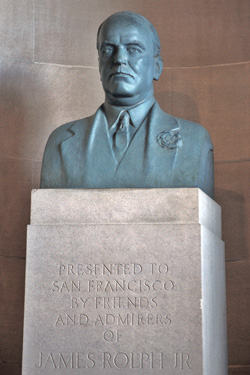
Born and raised in San Francisco, shipping magnate and California Governor
James Rolph, Jr. was the
City's 30th and longest serving mayor. During his campaign, he promised not only
honesty and clean government, but to be "mayor of all the people." With his dapper
appearance, exceptional memory and genuine affection for people, he was known as
“Sunny Jim.”
During his fifth term, he successfully ran for Governor of California.
After nineteen years as mayor, he resigned on the day of his inauguration,
January 6th, 1931. He died in office only three years later. His body was brought
back to San Francisco to lie in state in the Main Rotunda of City Hall.
This bronze bust on a tall granite base was executed in 1936 by sculptor Haig
Patigian and installed here in 1937. It was created as a companion piece to the statue
of Mayor Phelan that is directly across from it at the Goodlett Street entrance.
Edmond Godchaux
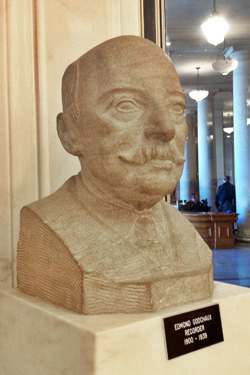
State Assemblyman, Health Board Secretary, businessman
and self-described 'permanent bachelor,'
Edmond Godchaux
was first elected to the Office of Recorder in 1899. He brought many cost saving innovations to the
Office such as numbered records and the typewriter. His three decades in that position are the
longest continuous service of any elected official in San Francisco history.
The sculptor Ralph Stackpole created this granite bust, which was donated to the City by the
Godchaux family in 1939. It is located just inside the entrance to the Assessor Recorder's
Office.
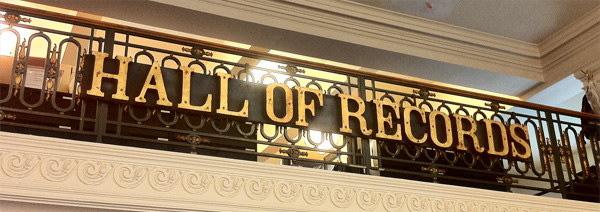
After the Great Earthquake and Fire of 1906, Edmond Godchaux
rescued these letters from the rubble of the old City Hall, and had them installed
here in the new Recorder's Office. They are made out of
Babbitt metal
and are heavily encrusted with gold.
James Seawell
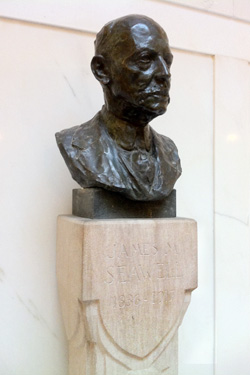
Judge James M. Seawell was born in 1836 at
Fort Gibson,
Indian Territory, where his father, an army captain, was stationed. He graduated
Harvard University in 1855, and the University of Kentucky law school in 1857.
He came to San Francisco in 1861, and was elected as a judge of the Superior
Court in 1892, where he remained a highly regarded member until his death in 1917.
His is the only statue on the 4th floor, where former
courtrooms are now used by various civic commissions.
The bust is the work of sculptor
Ralph Ward Stackpole,
the leading San Francisco artist of the 1920's and 30's. The pedestal was
designed by Arthur Brown, one of the architects of City Hall. The statue
was a gift of the San Francisco Bar Association.
City Hall Art
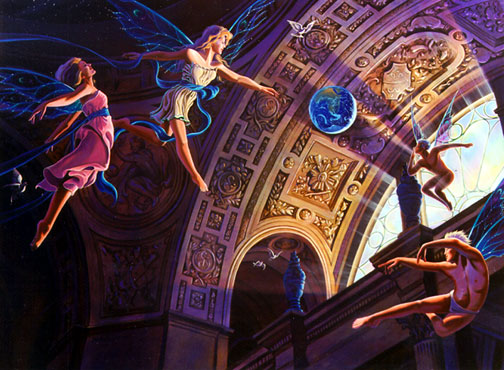
Heaven's Balcony by Jeffrey K. Bedrick
City Hall displays works of art in the South Light
Court and in a public gallery on the Ground Floor level.
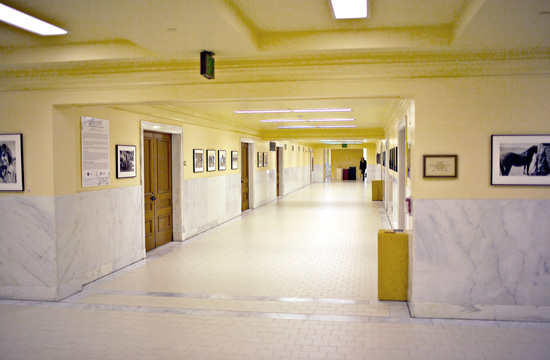
City Hall in the Movies
San Francisco City Hall has often served as a location
for major motion pictures. Clearly recognizable in films like the 1971 drama
"Dirty Harry," the 1978 thriller "Invasion of the Body Snatchers" or the 2008
biography "Milk," City Hall shows up less obviously, often surprisingly,
in many others, such as the 2010 animated feature "Megamind."
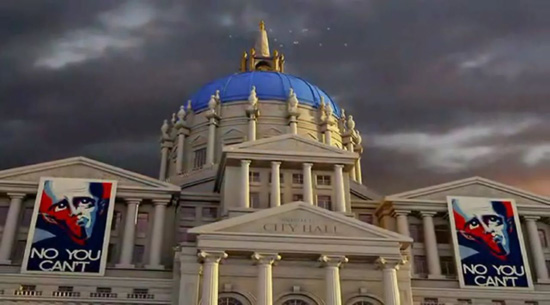
On occasion, City Hall will stand in for a university,
a library, a museum or some other generically imposing edifice as in the
1981 adventure "Raiders of the Lost Ark," seen below.
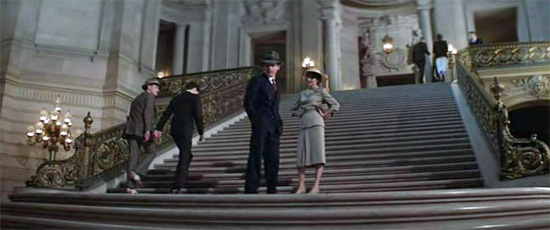
Several well-known movies that feature City Hall include:
Magnum Force (1973) • The Towerring Inferno (1974) • Foul Play (1978) •
A View to a Kill (1985) •
Jagged Edge (1985) • Class Action (1991) • Final Analysis (1992) •
Murder in the First (1995) • The Rock (1996) • Dr. Dolittle (1998) •
Bicentennial Man (1999) • Bedazzled (2000) • Boys and Girls (2000) •
The Wedding Planner (2001) • High Crimes (2002) • Twisted (2004) •
Contagion (2011) • Dawn of the Planet of the Apes (2014).
City Hall Events
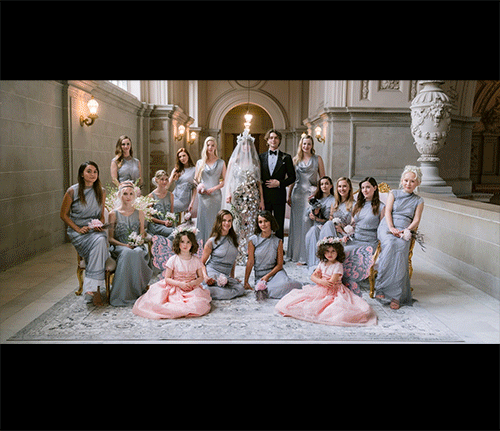
City Hall hosts many
civic and private events,
which often support services and functions for the people and the City of
San Francisco.
San Francisco City Hall
Restored to its former glory and updated to meet the
needs of the future, San Francisco City Hall is truly the people's palace,
and the crown jewel of San Francisco.
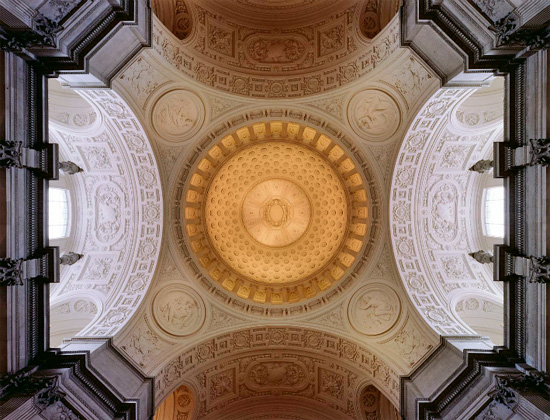
Photo by Robert Canfield - Architectural Photography
Virtual Tour Help
Toolbar Buttons
- "Help" - Press to open/close this window. It will
overlay all other windows. Navigation action will also close.
- "Contents" - Press to toggle a Table of Contents window.
Current position is indicated in bold italics.
Use scroll bar on right to see entire list.
Press or click any item to go to that entry.
Any Navigation action will also close this window.
- "Map" - If available, press "Map" button to show location
of item or area of entry. A title above will indicate floor number.
A red dot will locate the item. Press "Map" again to hide.
- "Next" - Press to go to next entry. See "Navigation"
- "Prev" - Press to go to previous entry.
Navigation
- To go to Next entry: mouse click on page, press Space Bar,
Right Arrow, Page Down, or swipe touch screen right-to-left.
- To go to Previous entry: press Left Arrow, Page Up
or swipe screen left-toright.
- To go to first page: press "Home".
- To go to last page: press "End".
Key Commands
- "A" toggles between one slide and all slides.
- "C" or "T" toggles the "Table of Contents".
- "H" toggles this "Help" window.
- "K" toggles use of mouse-click to advance.
- "M" toggles a floor location "Map".
- "Z" jumps to final entry.
Note
Not all keys are supported in all browsers. Some browsers may reserve
certain keys for browser control. This may vary between browsers.














